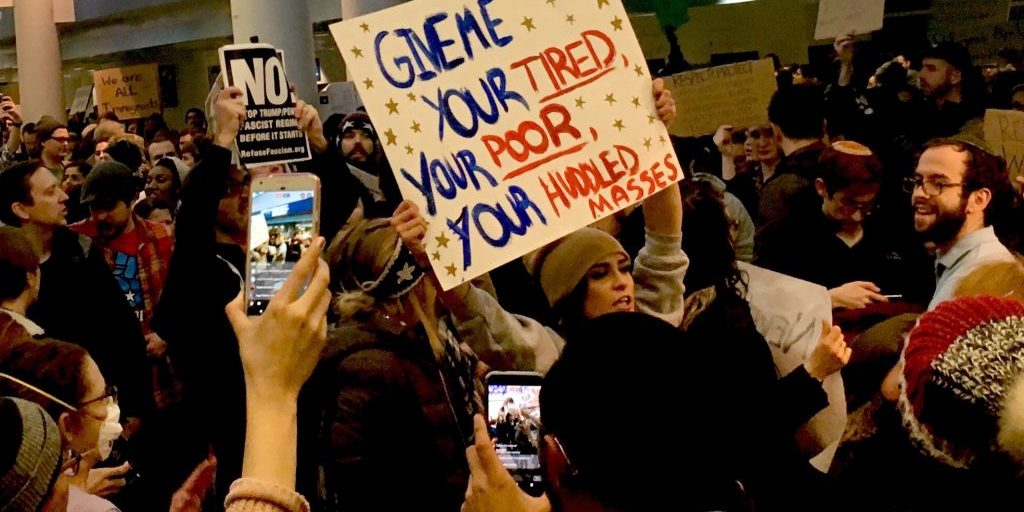The Chaos of Trump’s Travel Ban and Side Effects to Come
BY Kerrie Spencer

LISTEN
March 17, 2017: Maryland District Judge Theodore Chuang blocked the second version of the Trump travel ban hours before it was to take effect. He used the president’s “highly relevant” words throughout the campaign as evidence the order discriminates against Muslims. The Maryland decision is a preliminary injunction that applies only to the travel ban. Additionally, U.S. District Judge Derrick K. Watson of Hawaii granted a nationwide stay of the ban on Tuesday. The Hawaii decision temporarily blocks the travel ban, the cap on the number of refugees who may enter the U.S. and a proposed temporary travel ban on refugees.
Original story continues:
The first travel ban, issued by President Donald Trump as an executive order on January 27, 2017 was not insignificant. Sounds of protest were heard around the world. The impact of the second revised travel ban ostensibly remains the same — a religious ban against Muslims, all under the slogan to “Make America Great Again.”
The travel ban which allegedly serves to protect national security, created untold angst and confusion at airports, affecting approximately 60,000 foreigners. U.S. District Court Judge James Robart stopped the first ban by temporarily suspending parts of the order. Additionally, two attorneys general from Washington state and Minnesota challenged the ban. A federal appeals court in San Francisco rejected an emergency appeal launched by the White House. Later, Hawaii’s attorney general filed a motion to join the lawsuit.
The apparent stalemate resulted in an angry, tweeting president promising to see the court “in court.” The second, revised travel ban, which removed Iraq, from the travel list was issued March 6, 2017. However, the case may ultimately land in the Supreme Court, as it is possible that both sides intend to appeal. Already Massachusetts, Oregon, New York and Washington State are following Hawaii in challenging the revised travel order, saying it still amounts to an unconstitutional ban on Muslims.
Despite issuing a revised travel ban that may be judge-proof and harder to argue that it is a religious ban, the long-term effect is the same as the January 27, 2017 order. There is going to be a list of countries whose citizens are blacklisted indefinitely from the United States. As a further consequence of this ban, an increased scrutiny and tougher regulations will lead to an even smaller number of refugees admitted into the country. However, this is only the tip of the iceberg. The travel ban affects other sectors such as the economy, tourism, education and employment industry.
Most who are in favor of this ban see it as barring potential terrorists from entering the country. However, little thought is given to the possibility of terrorists that may already be in the country. Bans do not bar those already inside. Bans do however affect a large number of people that would be coming to the U.S. for other reasons.
Consider this short list of events and situations that could affect the nation’s economy, employment, education and tourism sectors.
Sporting events
The revised travel ban could prevent the United States from hosting the 2026 Fédération Internationale de Football Association (FIFA) World Cup, an event that injects millions into a host’s local economy, boosts construction, creates jobs, and promotes diversity and inclusion. Qualifying teams must access the country or there is no event. Bidding has not yet begun, but if certain countries are indefinitely banned, it would directly affect FIFA choosing the United States to host the tournament. This is not the only major event that would help bolster the economy that may not be able to come to the United States.
The Trump Slump
The negative impact of the bans on tourism, is referred to as the Trump Slump. Tourism Economics of Wayne, PA indicates that the United States will lose 6.3 million visits by the end of 2018, which represents $10.8 billion in tourism spending. Additionally, approximately 90,000 Americans whose jobs are indirectly or directly dependent on tourism will be affected. Tourists are afraid to visit the United States. Washington’s Global Business Travel Association conducted a survey that reveals that 45 percent of European business travel professionals say they are less likely to schedule meetings or events in the United States.
Universities and education
Hawaii indicates that state universities would be harmed as the ban creates difficulties recruiting students and faculty. In addition, the local tourism economy would suffer significantly. This is already happening in Florida whenever the president flies to Mar-a-Lago. Areas around the resort are shut down for security reasons, thus causing the local economy to lose money. Other states report similar issues.
In 2016, 12,269 Iranian students studied at U.S. universities, at the a master's and doctorate level. Now, those with secured funding and approved for university courses in the near future may not be able to get into the country.
Business and tech
The tech industry also voiced its opposition to the travel ban. According to USA Today, the tech industry is worried that “significant and irreparable harm” can come to the businesses and their employees. If they are not able to fill current vacancies locally, they hire from abroad. If companies cannot hire foreigners and local people are not qualified, or plentiful enough, businesses cannot expand, workers are not hired and thus they do not contribute to the U.S. economy.
President Trump has suggested he is willing to appeal the decisions of the federal judges, all the way to the Supreme Court if necessary.
Photo: Amy Guth, Chicago, IL, Wikimedia Commons.
LATEST STORIES



